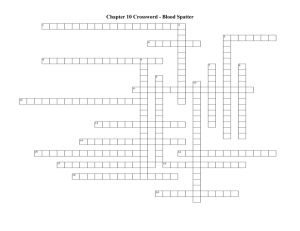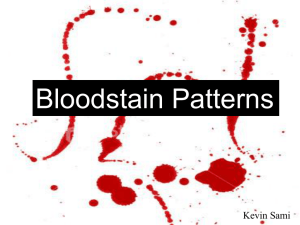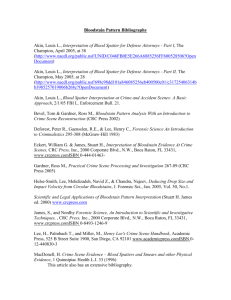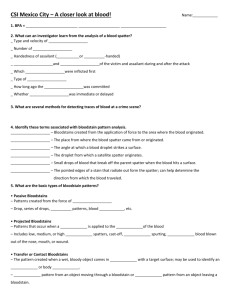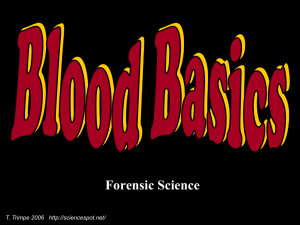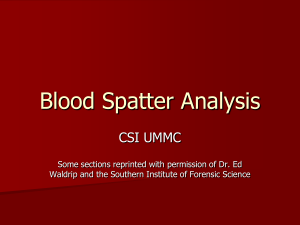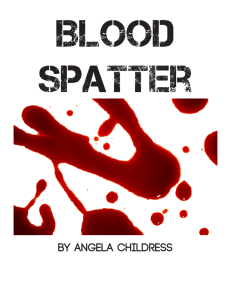Blood Splatter
advertisement
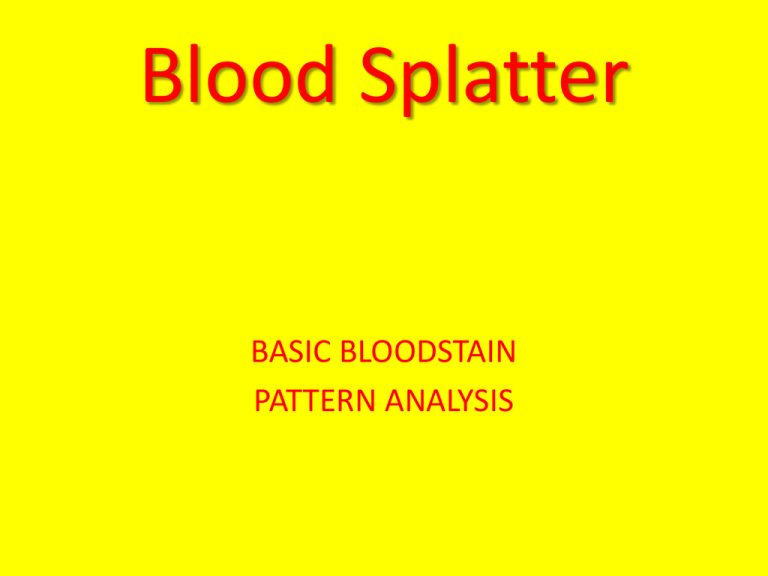
Blood Splatter BASIC BLOODSTAIN PATTERN ANALYSIS Blood Splatter • Bloodstain pattern analysis involves the scientific study of the static consequences resulting from dynamic blood shedding events. • A detailed study of bloodstain patterns at crime scenes often develops invaluable evidence. • The distribution, size and shape of bloodstains on a victim, on a suspect, or on the walls, floors, ceilings, or on objects at the scene can help reconstruct these blood shedding events. • Bloodstain pattern analysis can also help one evaluate the credibility of statements provided by a witness, a victim, or a suspect. CHARACTERISTICS OF BLOOD • When blood leaves the body as a drop, as spatter, or as a gushing flow from an artery, its behavior conforms to the laws of physics. • Understanding blood flows involves understanding the physical force involved in blood shedding events. CHARACTERISTICS OF BLOOD • As a fluid, blood has physical properties similar to the properties of water. • Blood is affected by physical forces much as water is affected by physical forces. • Fluids lack the ability to support a shearing stress. This property distinguishes fluids from solids. A fluid will flow under the influence of a shearing stress while a solid will not. CHARACTERISTICS OF BLOOD • Viscosity is a form of internal friction in fluids. • It results from frictional forces generated between layers of the fluid as they flow past each other. • Viscosity, then, is a measure of a fluids resistance to change in shape or flow BASIC BLOODSTAIN PATTERN ANALYSIS • Blood’s viscosity decreases with increases in blood’s velocity gradient. • Blood is a “shear thinning fluid.” • Blood drops hold together in free flight through the forces of both cohesion and surface tension. BASIC BLOODSTAIN PATTERN ANALYSIS • The maximum speed for a free-falling blood drop in air is 25.1 feet per second for a 0.05 ml drop. • Little change in the blood drop appears from 0 to 25 feet. There will be no change in the blood drop after 25 feet because at that point, it has reached its terminal velocity. • Only the target surface can change the shape or condition of the blood drop. BASIC BLOODSTAIN PATTERN ANALYSIS • Blood striking an object at angles less than 90 degrees produces a tear drop shape. • A 90-degree impact angle will yield a circular shape. • In tear-drop stains, the sharp end points in the direction of travel. This pointed end indicates the blood drops forward direction of travel prior to striking the surface. BASIC BLOODSTAIN PATTERN ANALYSIS • Transfer Pattern - occurs when a wet bloody surface contacts a second unstained surface creating recognizable mirror image or at least a recognizable portion of the original surface. • Examples of common transfer patterns: a) Clothing patterns which reproduce fabric weaves b) Shoe print and hand print transfers BASIC BLOODSTAIN PATTERN ANALYSIS • Swipe Pattern - the transfer of blood onto a surface not already contaminated with blood. One side is usually feathered which indicates the direction of travel. BASIC BLOODSTAIN PATTERN ANALYSIS • Wipe Pattern - created when an object moves through blood that has not completely dried and moves, removes, or otherwise alters it. • Smear Pattern - a large volume of blood, at least 0.5 ml, which has been distorted so much that further classification is not possible. BASIC BLOODSTAIN PATTERN ANALYSIS • Smudge Patterns - another reference to a bloodstain that has been distorted to such a degree that further classification is not possible. BASIC BLOODSTAIN PATTERN ANALYSIS CAST-OFF • During a beating with an instrument which produces the bleeding, blood will not normally collect on the surface of the instrument from the first strike. • On subsequent strikes at the same location, blood will adhere to the instrument since it now strikes a blood source. When the instrument is raised or swung backward, its movement allows small drops of blood to be released from its surface. BASIC BLOODSTAIN PATTERN ANALYSIS The movement and the number of swings can often be documented by examining the cast-off pattern. a) The instruments range from hammers, bats, tools, and hands, to just about anything that can be used as weapon – the only requirement is that the object becomes bloodstained during multiple impacts. b) Cast off bloodstains also can result from multiple stabbings. BASIC BLOODSTAIN PATTERN ANALYSIS EXPIRATED BLOODSTAINS 1. This type of pattern usually occurs when blood is expelled through the mouth, nose, or some perforating airway injury. a) The victim may have had a gunshot wound which results in coughing up blood through his mouth and nose. b) The victim may also have internal injuries which cause blood to be coughed up or exhaled. c) CPR or other resuscitative efforts may also produce such stains. BASIC BLOODSTAIN PATTERN ANALYSIS PROJECTED BLOOD STAINS • This type of pattern, also called arterial spurting, usually occurs when an artery is damaged and the blood spurts or gushes from the wound in large volume pulses. It continues spurting as long as the heart continues beating. BASIC BLOODSTAIN PATTERN ANALYSIS GUNSHOT WOUNDS 1. Forward spatter a) Forward spatter is blood that travels in the same direction as the source of the energy or force which produced the spatter. b) Forward spatter varies in size depending upon the injury. The size could vary from .1 millimeter or smaller with some larger stains obvious. The smaller bloodstains do not travel as far as the larger bloodstains. BASIC BLOODSTAIN PATTERN ANALYSIS 2. Back spatter a) Back spatter is blood that is directed back toward the source of the energy producing the blood drops. b) b) Back spatter often results from a gunshot entrance wound to a body. The unimpeded blood spatters back toward the weapon. BASIC BLOODSTAIN PATTERN ANALYSIS 3. Draw-back effect a) The draw-back effect sucks blood into the muzzle of a firearm immediately after its discharge due to the partial vacuum created by contracting discharge gasses. b) b) The draw-back effect can be observed in contact gunshot wounds but the effect(s) of compensators, suppressors and silencing devices as well as any other intervening items may alter the outcome. DETERMINING BLOODSHED ORIGIN 1. The location from which blood was shed can often be determined. 2. Point-of-convergence a) This is the two dimensional point establishing a bloodstain pattern’s deposition direction. It is determined by tracing the long axis of well defined bloodstains within a single pattern back to a point where the axes intersect or converge. b) This two dimensional point is used to help determine the three dimensional point of origin, or the approximate position of the victim at the time blood was shed. DETERMINING BLOODSHED ORIGIN 3. Point-of-origin a) Measuring the length and width of blood drops and using trigonometry allows us to determine an approximate point of origin. b) The arc sin of the width of the bloodstain in mm = the impact angle the length of the bloodstain in mm c) Only experienced analysts trained in this technique should perform these measurements. d) Strings can be placed over blood drops along the axes of the stains at the calculated impact angles, and a resulting point of origin can be visualized in three dimensions. e) Error rates are a hotly debated topic, but ‘error rate’ for point of origin calculations can be thought of as an area about the size of a basketball. SUMMARY 1. Often at crime scenes, the physical evidence contradicts eyewitness testimony. Physical evidence, including bloodstain evidence, is more reliable than evidence based solely upon witness memory. 2. To be presented accurately and usefully in court bloodstain evidence must be recognized, documented, preserved, and correctly evaluated. 3. Bloodstain pattern analysis is a valuable tool to help explain blood-shedding events. Terms ANGLE OF IMPACT - The acute angle formed between the direction of a blood drop and the plane of the surface it strikes ARTERIAL SPURTING (OR GUSHING) PATTERN - Bloodstain pattern(s) resulting from blood exiting the body under pressure from a breached artery BACK SPATTER - Blood directed back towards the source of energy or force that caused the spatter BLOODSTAIN - Evidence that liquid blood has come into contact with a surface. BUBBLE RINGS - Rings in blood that result when blood containing air bubbles dries and retains the bubble’s circular configuration as a dried outline CAST-OFF PATTERN - A bloodstain pattern created when blood is released or thrown from a blood-bearing object in motion DIRECTION OF FLIGHT - The trajectory of a blood drop which can be established by its angle of impact and directionality angle • DIRECTIONALITY ANGLE - The angle between the long axis of a bloodstain and a predetermined line on the plane of the target surface which represents 0 degrees • DIRECTIONALITY - The directionality of a bloodstain or pattern which indicates the direction the blood was traveling when it impacted the target surface. Directionality of a blood drop’s flight can usually be established from the geometric shape of its bloodstain • DRAW-BACK EFFECT - Blood in the barrel of a firearm that has been drawn backward into the muzzle • DRIP PATTERN - A bloodstain pattern which results from blood dripping into blood. • EXPIRATED BLOOD - Blood that is blown out of the nose, mouth, or a wound because of air pressure and/or airflow which is the propelling force • FLIGHT PATH - The path of the blood drop, as it moves though space, from the impact site to the target • FLOW PATTERN - A change in the shape and direction of a bloodstain due to the influence of gravity or movement of the object • FORWARD SPATTER - Blood which travels in the same direction as the source of energy or force which caused the spatter • IMPACT PATTERN - Bloodstain pattern caused when blood received a blow or force • resulting in the random dispersion of smaller drops of blood • IMPACT SITE - That point where force encounters a source of blood • MISTING - Blood that has been reduced to a fine spray, as a result of the energy or force applied to it • PARENT DROP - A drop of blood from which a wave, cast-off, or satellite spatter originates • PASSIVE DROP (BLEEDING) - Bloodstain drop(s) created or formed by the force of gravity acting alone • PERIMETER STAIN - A bloodstain that consists of only its outer periphery, the central • area having been removed by wiping or flaking after liquid blood has partially or completely dried • POINT (AREA) OF CONVERGENCE - The common point (area), on a two dimensional surface, over which the directionality of several blood drops can be retraced • POINT (AREA) OF ORIGIN - The common point (area) in threedimensional space to which the trajectories of several blood drops can be retraced • PROJECTED BLOOD PATTERN - A bloodstain pattern, such as arterial spurting, that is produced by blood released under pressure as opposed to an impact • RICOCHET- The deflection of blood after impact with one target surface that results in staining of a second target surface • SATELLITE SPATTER - Small droplets of blood that are distributed around a drop or pool of blood as a result of the blood impacting the target surface • SPATTER- That blood which has been dispersed as a result of force applied to a source of blood. Patterns produced are often characteristic of the nature of the forces that created them • SPINE - The pointed or elongated stains which radiate away from the central area of a bloodstain • SWIPE PATTERN - The transfer of blood from a moving source onto an unstained surface – the direction of travel may be determined by the feathered edge of the pattern • TARGET - A surface upon which blood has been deposited • TRANSFER/CONTACT PATTERN - A bloodstain pattern created when a wet, bloody • surface comes in contact with a second surface. A recognizable image of all or a portion of the original surface may be observed in the pattern • VOID - An absence of stains in an otherwise continuous bloodstain pattern • WAVE CAST-OFF - A small blood drop that originates from a parent drop of blood due to the wave-like action of the liquid in conjunction with striking a surface • WIPE PATTERN - A bloodstain pattern created when an object moves through an existing stain, removing and/or altering its appearance • http://www.youtube.com/watch?v=2UV_moa F45I&feature=related
